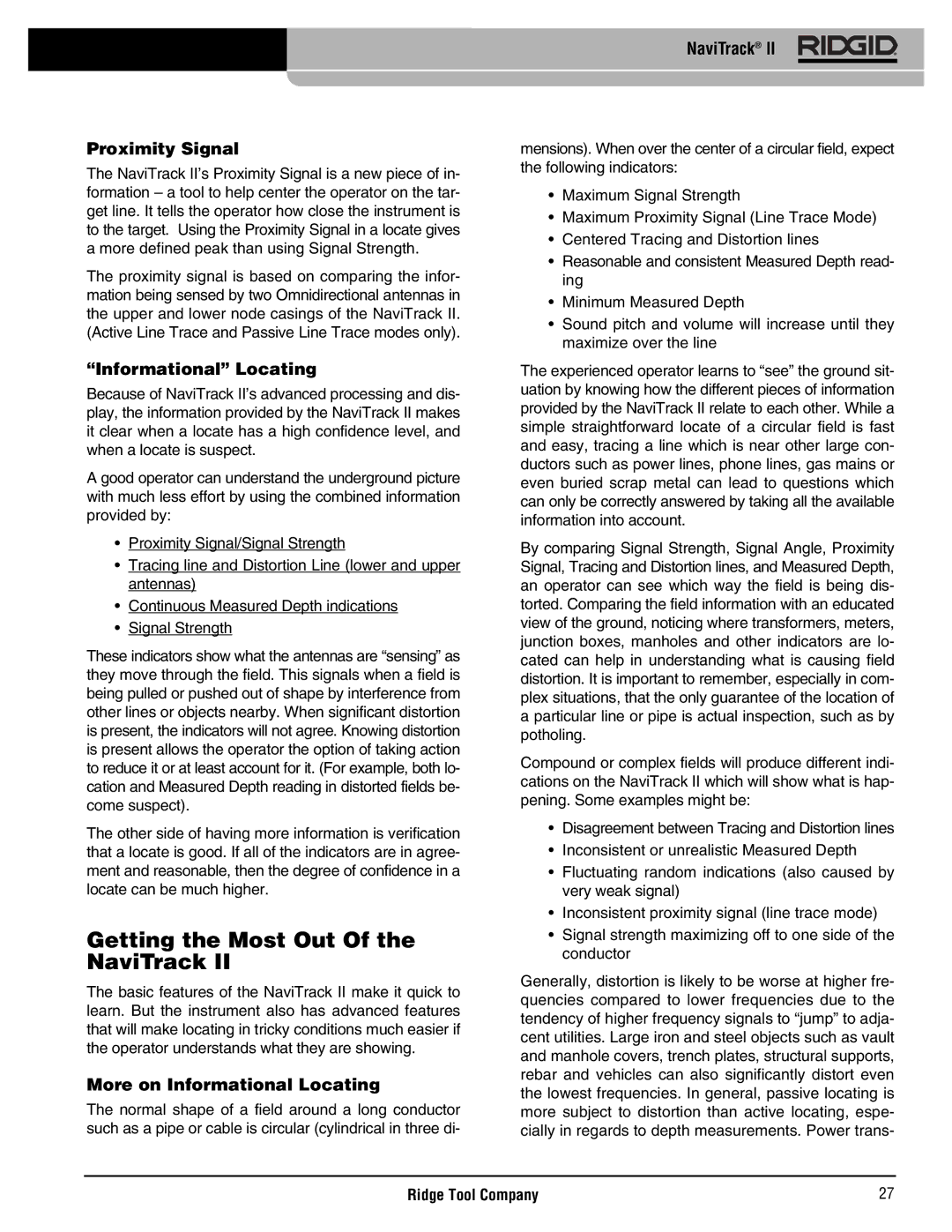
NaviTrack® II
Proximity Signal
The NaviTrack II’s Proximity Signal is a new piece of in- formation – a tool to help center the operator on the tar- get line. It tells the operator how close the instrument is to the target. Using the Proximity Signal in a locate gives a more defined peak than using Signal Strength.
The proximity signal is based on comparing the infor- mation being sensed by two Omnidirectional antennas in the upper and lower node casings of the NaviTrack II. (Active Line Trace and Passive Line Trace modes only).
“Informational” Locating
Because of NaviTrack II’s advanced processing and dis- play, the information provided by the NaviTrack II makes it clear when a locate has a high confidence level, and when a locate is suspect.
A good operator can understand the underground picture with much less effort by using the combined information provided by:
•Proximity Signal/Signal Strength
•Tracing line and Distortion Line (lower and upper antennas)
•Continuous Measured Depth indications
•Signal Strength
These indicators show what the antennas are “sensing” as they move through the field. This signals when a field is being pulled or pushed out of shape by interference from other lines or objects nearby. When significant distortion is present, the indicators will not agree. Knowing distortion is present allows the operator the option of taking action to reduce it or at least account for it. (For example, both lo- cation and Measured Depth reading in distorted fields be- come suspect).
The other side of having more information is verification that a locate is good. If all of the indicators are in agree- ment and reasonable, then the degree of confidence in a locate can be much higher.
Getting the Most Out Of the NaviTrack II
The basic features of the NaviTrack II make it quick to learn. But the instrument also has advanced features that will make locating in tricky conditions much easier if the operator understands what they are showing.
More on Informational Locating
The normal shape of a field around a long conductor such as a pipe or cable is circular (cylindrical in three di-
mensions). When over the center of a circular field, expect the following indicators:
•Maximum Signal Strength
•Maximum Proximity Signal (Line Trace Mode)
•Centered Tracing and Distortion lines
•Reasonable and consistent Measured Depth read- ing
•Minimum Measured Depth
•Sound pitch and volume will increase until they maximize over the line
The experienced operator learns to “see” the ground sit- uation by knowing how the different pieces of information provided by the NaviTrack II relate to each other. While a simple straightforward locate of a circular field is fast and easy, tracing a line which is near other large con- ductors such as power lines, phone lines, gas mains or even buried scrap metal can lead to questions which can only be correctly answered by taking all the available information into account.
By comparing Signal Strength, Signal Angle, Proximity Signal, Tracing and Distortion lines, and Measured Depth, an operator can see which way the field is being dis- torted. Comparing the field information with an educated view of the ground, noticing where transformers, meters, junction boxes, manholes and other indicators are lo- cated can help in understanding what is causing field distortion. It is important to remember, especially in com- plex situations, that the only guarantee of the location of a particular line or pipe is actual inspection, such as by potholing.
Compound or complex fields will produce different indi- cations on the NaviTrack II which will show what is hap- pening. Some examples might be:
•Disagreement between Tracing and Distortion lines
•Inconsistent or unrealistic Measured Depth
•Fluctuating random indications (also caused by very weak signal)
•Inconsistent proximity signal (line trace mode)
•Signal strength maximizing off to one side of the conductor
Generally, distortion is likely to be worse at higher fre- quencies compared to lower frequencies due to the tendency of higher frequency signals to “jump” to adja- cent utilities. Large iron and steel objects such as vault and manhole covers, trench plates, structural supports, rebar and vehicles can also significantly distort even the lowest frequencies. In general, passive locating is more subject to distortion than active locating, espe- cially in regards to depth measurements. Power trans-
Ridge Tool Company | 27 |
